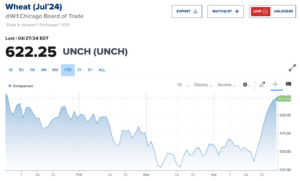Agriculture Secretary Brooke Rollins said on Tuesday that the Trump administration will announce a 'bridge payment' for farmers next week that is designed to provide short-term relief while longer trade…
Wheat Futures Erasing Early-Year Losses
Bloomberg’s Áine Quinn and Tarso Veloso reported late last week that “wheat futures traded in Chicago nearly erased losses so far this year, with prices climbing on concerns over weather in key producers. The recovery comes as traders worry that weather in Russia, Europe and the US could impact supplies.”
“’Concerns over crop prospects in Russia’s southern Caucasus region, a major source of the country’s wheat exports, gained extra potency with weather maps showing the area staying largely dry through the first week of May,’ CRM Group analysts wrote in a note,” according to Quinn and Veloso. “Some worries remain too about the potential for some losses in Europe to recent frosts.”
On Friday, wheat closed at 622.25, which Ag Week’s Michael Johnson reported was “the highest weekly close for wheat in two years,” according to Randy Martinson of Martinson Ag Risk Management.

Martinson said that “dry conditions in the southern Plains are a factor in helping to give wheat a much needed boost in the markets (last) week,” according to Johnson’s reporting. “…He points to western Kansas and the panhandle of Oklahoma as missing out on these recent rains. The market is also reacting to drier conditions in Russia and Ukraine.”
Reuters reported on Saturday that “Russia’s state weather forecaster said on Saturday it sees a threat of drought persisting in May in the eastern half of the Southern Federal District, one of the country’s key regions for wheat cultivation and exports.”
Wheat Outlook Remains Bearish Despite Some Bullish Signals
With the increasing prices since March, Reuters reports that “money managers reduced their net short position in CBOT wheat futures and options to 76,184 contracts from 96,403 a week earlier. That included funds’ largest round of short covering since December.”
“The new net short is a seven-week low but remains historically large. Money managers have maintained a net short in CBOT wheat since early July 2022, when most-active futures were trading in the $8-per-bushel range,” Reuters reported. “The latest week marks funds’ 95th consecutive week in bearish CBOT wheat territory, approaching the record 100 set between mid-2015 and mid-2017, a period characterized by heavy global supplies and decade-low prices.”
Arlan Suderman, chief commodities economist for StoneX, told Successful Farming’s Cassidy Walter on Friday that “prices are now getting into over-bought territory. Fund short covering has been orderly thus far, with few signs of panic. It’s still early, with plenty of time yet for weather conditions in the Plains, Europe, and Russia to improve.”
“Rains again missed key production areas of the central and Southern Plains overnight, where we may see another week of declining condition scores reflected in Monday’s (USDA) numbers,” Suderman said, according to Walter. “However, the key area to watch is southern Russia. That’s the area that’s been driving world prices lower over the past year plus. That’s where the world cash price is essentially set. Russia is still pushing cheap wheat out through its ports at a record pace, keeping the world supplied.”
Wheat Prices to Start the Week
Reuters reported Monday morning that “Chicago wheat futures edged lower on Monday but remained near four-month highs after concerns that adverse weather conditions in Russia, Europe and the United States could reduce supply pushed prices up around 10% last week.”





